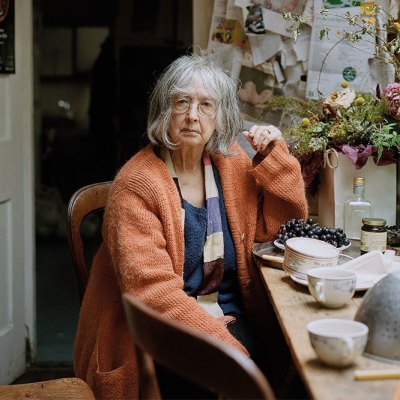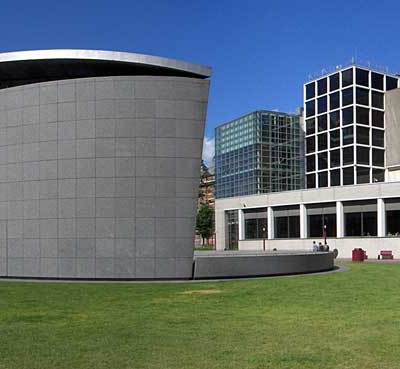There is a fascination with the spaces where artists live and work. That’s why so many of their homes are later turned into museums, their workshops preserved as permanent exhibits. Granted access to an artist’s studio, we peer at the reference books on the shelves, the paint-flecked furniture, the brushes waiting to be picked up again. These places seem to promise a peek behind the curtain: here’s where the magic actually happens. Yet at the same time, they often carry their own sense of mystery.
In Rosalind Nashashibi’s film Vivian’s Garden, we enter the living and working spaces of the artist Vivian Suter. (The film, which was first shown at Documenta in 2017, will be screened on 2 April as part of an exhibition of Suter’s paintings at Camden Arts Centre.) Since the 1980s Suter – who grew up in Basel – has lived in Guatemala in a lakeside village called Panajachel, setting up her home and studios on the site of a former coffee plantation now dense with tropical foliage. When Nashashibi visited, Suter was living with her mother, the Austrian-born artist Elisabeth Wild, who recently died at the age of 98. The film follows mother and daughter as they go about their daily activities and interactions – with each other, with Suter’s three dogs, and with the local workers whom they employ to help with household tasks. Wild works on her small paper collages indoors, sitting in her wheelchair; Suter works outside, the fronds of trees casting shadows across her propped-up canvases, fallen leaves collecting on those laid out on the ground. Sunlight filters gently through the canopies and there’s a soundtrack of dogs barking and birds chirping. It’s quite otherworldly.
Installation view of ‘Vivian Suter: Tintin’s Sofa’ at Camden Arts Centre, 2019. Photo: Luke Walker

The film offers only glimpses of a few canvases, dozens of which are now on display at Camden Arts Centre, having been transported halfway across the globe. There are a few schematic figures and landscapes – the purple-brown outline of a dog, an indigo person striding into what looks like a body of water, a tangerine sun. Most of the paintings, though, are abstract. Some contain clearly defined geometric shapes and patterns; others are simply fields of colour, thin, dribbling layers of paint applied with thick, quick brushstrokes. No tone is off-limits: there are earthy browns and greens, but also rich jewel shades and pastel pinks and the occasional burst of neon. The only colour that appears in every painting is the neutral off-white of the unprimed canvas itself, expanses of which Suter often leaves unpainted, and the frayed, unstretched edges of which she always leaves visible. Without their conventional supports, the canvases crease and occasionally curl in at the corners. Look closely, and you might notice certain bits of debris or marks: a wayward thread, a paint-encrusted twig, a leaf, a shoe print, a paw print.
Installation view of ‘Vivian Suter: Tintin’s Sofa’ at Camden Arts Centre, 2019. Photo: Luke Walker

The inclusion of these details is intentional. On two occasions in the past, Suter’s studio, along with the art inside it, was destroyed by huge storms. Now, once finished painting, she deliberately leaves her canvases outdoors to face the elements – or to be stepped on by her dogs. ‘It’s my life,’ she has said of her work. ‘A document of moments.’ Suter’s immediate environment is clearly entwined with her art – so much so, that I wonder whether something is lost in the translation to an indoor setting with little natural light. The colours, the stretches of bare canvas, appear slightly dulled; their frays a little forlorn. Yet in other ways, Suter’s world has been brought right into the galleries. The paintings are densely installed so as to recall a canopy: canvases are tacked to almost every available wall space; suspended in rows from the ceiling and slats on window blinds; piled on top of each other on the floor like undergrowth. A dozen or so hang from a makeshift wood-and-metal rail, apparently modelled on the one Suter uses to store her paintings back home.
A similar wooden structure has been built outside, on the paved area of the garden accessed through the Camden Arts Centre cafe, which faces on to the busy Finchley Road – a world away from the rainforest. When I visit, I encounter a sign that reads: ‘Due to the forecasted strong winds and heavy rains, Vivian Suter’s outside paintings will not be on display.’ It seems the paintings have been deemed weathered enough by nature’s unpredictable forces. Later, as I am about to leave, I notice a man removing the sign so I decide to check if the works have been returned to the garden. It’s not raining – in fact, the sky is a clear blue – but there is a noticeable wind. It takes a moment for me to spot the paintings, hanging from wooden slats. There is a row of plastic sheets forming a roof over the slats but it’s no match for the gusty weather, which sends the multicoloured canvases billowing back and forth. Animated by this wind, they whip against one another quite violently, almost drowning out the noise of the traffic from the nearby road.
Installation view of ‘Vivian Suter: Tintin’s Sofa’ at Camden Arts Centre, 2019. Photo: Luke Walker

‘Vivian Suter: Tintin’s Sofa’ is at the Camden Arts Centre, London, until 5 April 2020.



